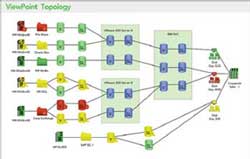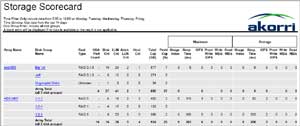Server and storage virtualization technologies offer IT managers the capability to more effectively allocate their data center resources. However, monitoring and managing a virtual infrastructure isn’t without its challenges when it comes to understanding server and storage resource utilization.
BalancePoint 2.0 expands support for virtualized storage, adds a Key Performance Indicator metric and offers its management tools as a virtual appliance.
 |
| BalancePoint maps your virtual infrastructure and uses a green light, yellow light, red light approach to show you the level of performance for servers, storage and applications. |
Providing visibility and analysis into performance data is where Akorri, a Littleton, Mass.-based provider of performance management tools for virtualized data centers thinks it can help. Today, the company announced BalancePoint 2.0, which adds GuidePoint Performance Index, scorecard reporting and storage virtualization support.
BalancePoint software is designed to analyze your applications, servers and storage devices. For example, BalancePoint looks to provide visibility and control for applications running on VMware by mapping the server and storage resources supporting each application to ensure optimal performance.
 Recent Articles
» Virtually Speaking: Waiting to Shift Gears» IBM Sweetens Virtualization for SMBs » Virtually Speaking: VMware Comes Down to Earth |
BalancePoint works across multiple domains, according to Mike Matchett, director of product management, at Akorri. “You plug the appliance into your network without needing agents, and it maps and monitors [your server and storage infrastructure].” The maps use green, yellow and red to visually represent the health of your data center operation.
The Metric System
BalancePoint 2.0’s GuidePoint Performance Index is designed to offer a metric that ensures your server and storage infrastructure is optimally matched to an application’s workload requirements, Matchett said. The Performance Index provides you with a mathematically based key performance indicator (KPI) to help you make the best IT optimization and IT purchase decisions.
|
Unsure About an Acronym or Term? Search the ServerWatch Glossary |
Matchett said that a Performance Index of 100 means that the assigned IT resources (servers, storage and so on) are optimally matched to your infrastructure. A index of more than 100 indicates that the assigned IT resources are over-utilized and performance is poor. And a Performance Index significantly less than 100 illustrates under-utilized and IT management should consider efficiency initiatives such as server consolidation or storage tiering.
The company’s Scorecard Reporting systems is designed to provide key performance and utilization information for VMware’s ESX Server and virtual machine (VM), physical servers, application services and storage usage.
 |
| You can’t tell how well your storage (or server or application) is performing without a scorecard. |
BalancePoint 2.0 also offers storage virtualization support for IBM’s SAN Volume Controller (SVC) and Hitachi Data Systems Universal Volume Manager (UVM), which Akorri claims makes its the only cross domain performance management solutions to support both virtualized storage and virtualized servers. Matchett said support for other storage platforms will announced soon.
BalancePoint 2.0 is also now available as a virtual appliance, which will be a quicker and more cost effective option, Matchett said. The virtual appliance is a pre-built, pre-configured, ready-to-run application packaged with an operating system inside a VM that could be delivered on a DVD, he said. He added that Akorri now has 20 channel partners covering the U.S. and Canada. These partners can help ensure smooth deployments of virtual appliances.
Pricing for BalancePoint 2.0 is based on the amount of a storage a customer has to manage, according to Matchett. The entry level option for companies with less than 5 terabytes of storage begins $12,500. A company with up to 30TB of storage would pay $75,000, he said. For data centers with greater storage capacity, enterprise pricing is available.
Dan Muse is executive editor of internet.com’s Small Business Channel, EarthWeb’s Networking Channel and ServerWatch.

